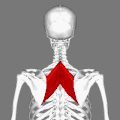Rhomboid Major Muscles often simply called the rhomboids, are rhombus-shaped muscles associated with the scapula. There are two rhomboid muscles on each side of the upper back. The large rhombus-shaped muscle, located under the trapezius muscle in the upper part of the thoracic region of the back, and also the small muscle, in the same way, participate in the movement of the scapula.
- Rhomboid major muscle
- Rhomboid minor muscle
At a Glance of Rhomboid Major
-
Function – Retracts and rotates the scapula
-
Origin – Spinous processes of T2 to T5 vertebrae
-
Insertion – Inferomedial border of the scapula
-
Innervation – Dorsal scapular nerve (C5)
Anatomy of Rhomboid Major Muscles
The rhomboid major muscle originates from the spinous processes of vertebrae T2-T5, while it inserts to the medial border of the scapula. The rhomboid minor muscle originates from the nuchal ligament and spinous processes of vertebrae C7-T1. Both muscles are innervated by the dorsal scapular nerve, a branch of the brachial plexus. Their functions are the following:[rx][rx][rx]
- Drawing scapula superomedially
- Supporting scapula
- Rotating glenoid cavity inferiorly
The rhomboid major arises from the spinous processes of the thoracic vertebrae T2 to T5 as well as the supraspinous ligament. It inserts on the medial border of the scapula, from about the level of the scapular spine to the scapula’s inferior angle. [rx]
The rhomboid major is considered a superficial back muscle. It is deep to the trapezius and is located directly inferior to the rhomboid minor. As the word rhomboid suggests, the rhomboid major is diamond-shaped. The major in its name indicates that it is the larger of the two rhomboids. The two rhomboids are sometimes fused into a single muscle. [rx]
Nerve Supply of Rhomboid Major Muscles
Blood supply
Both rhomboid muscles also derive their arterial blood supply from the dorsal scapular artery.
Functions of Rhomboid Major Muscles
- The rhomboid major helps to hold the scapula (and thus the upper limb) onto the ribcage. Other muscles that perform this function include the serratus anterior and pectoralis minor.
- Both rhomboids (major and minor) also act to retract the scapula, pulling it towards the vertebral column.
- The rhomboids work collectively with the levator scapulae muscles to elevate the medial border of the scapula, downwardly rotating the scapula with respect to the glenohumeral joint. Antagonists to this function (upward rotators of the scapulae) are the serratus anterior and lower fibers of the trapezius. If the lower fibers are inactive, the serratus anterior and upper trapezius work in tandem with rhomboids and elevators to elevate the entire scapula.
References



